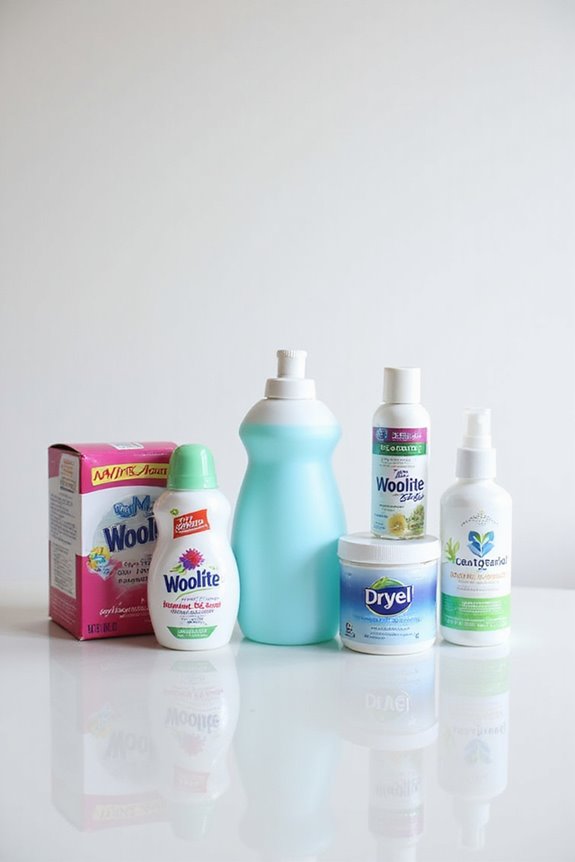To use fabric softener in high-efficiency washers, we should pick HE-compatible options first. These softeners lessen suds, keeping our machines safe. Always add softener in the designated compartment marked with a flower symbol, or during the rinse cycle if there’s no dispenser. Remember not to pour it directly on clothes! This way, we avoid residue and keep things fresh. Want tips on choosing the best softener? Keep going, and we’ll find the perfect one for you!
Key Takeaways
- Use HE-compatible fabric softeners to prevent buildup and protect your washer’s performance.
- Measure the correct amount of softener and use the designated dispenser marked with a flower symbol.
- Add fabric softener during the rinse cycle for optimal distribution and effectiveness.
- Avoid direct contact with clothes when adding softener manually; use a Downy Ball® for top-loaders if needed.
- Choose hypoallergenic options if you have sensitive skin or respiratory issues to minimize irritation risks.
Understanding HE Washers and Fabric Softener Compatibility
When we think about doing laundry with high-efficiency (HE) washers, it’s important to understand how fabric softeners fit into the mix. HE washer efficiency relies on using less water, which means we need to be careful about the fabric softener formulations we choose. Not all fabric softeners work well in these machines. For instance, we should look for ones labeled as HE-compatible, as they’re low-sudsing and designed for peak performance. Using the dedicated fabric softener compartment is vital, too; it guarantees that the softener releases at the right time during the rinse cycle. If we mix products or use the wrong type, we risk clogging or damaging our machine. Trust us, no one wants that headache! Additionally, selecting hypoallergenic products can be beneficial for those with sensitive skin, ensuring a gentle wash without irritation.
Proper Dispensing Techniques for Fabric Softener
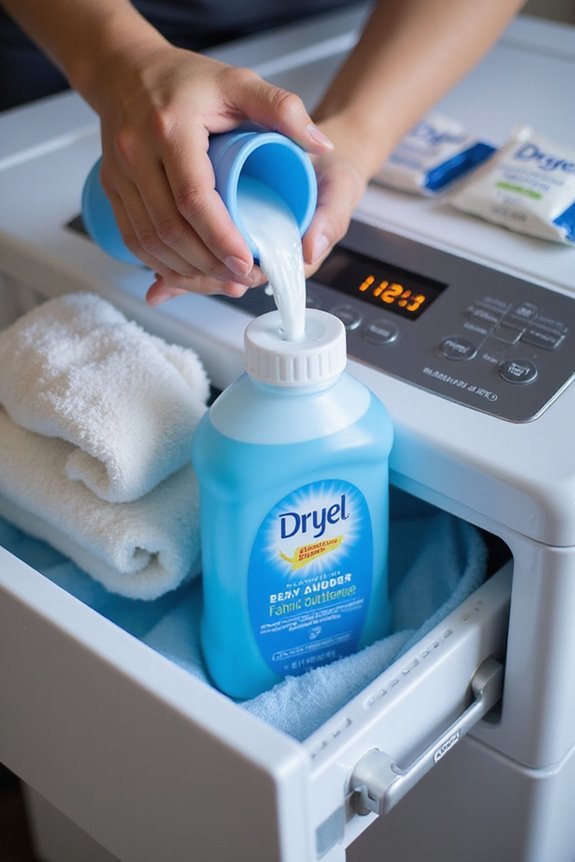
Getting the hang of using fabric softener in HE washers is all about knowing how to properly dispense it. First, we need to find the fabric softener dispenser, often marked with a flower symbol. We should measure the right amount based on load size—too much can cause residue, which is one of those pesky fabric softener myths! If our washer lacks a dispenser, we can add softener manually during the rinse cycle, just remember to avoid direct contact with clothes to prevent stains. For top-loaders, a Downy Ball® can work wonders. By following these simple techniques, we make certain our laundry stays soft and fresh, while steering clear of common pitfalls. Many brands, like Gain Liquid Fabric Softener, offer various scents that can enhance your laundry experience. Happy washing!
Timing the Use of Fabric Softener in Wash Cycles
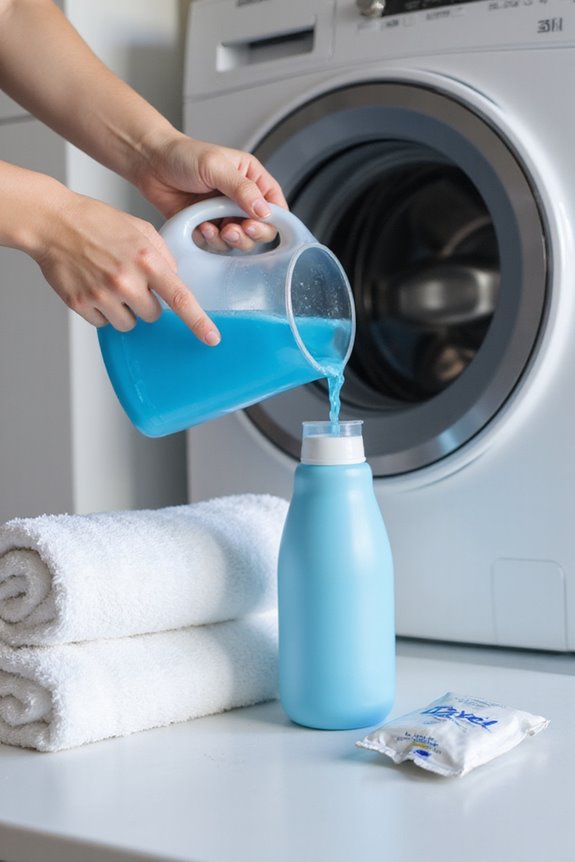
To make certain our laundry comes out soft and fresh, timing is everything when it comes to using fabric softener in HE washers. We should always add fabric softener during the rinse cycle, not the wash cycle. If we don’t, it might just wash away too soon. Most HE washers have built-in dispensers that release the softener at the right moment. This means we don’t have to worry about it! If our washer doesn’t have an automatic dispenser, we’ll need to manually add softener right when the rinse cycle starts. Using the right timing techniques guarantees even distribution. And trust us, the last thing we want is stained clothes or a concentrated mess. Additionally, using fabric softener with softening ingredients can enhance the overall freshness of our laundry. Let’s get it right!
Benefits of Using Fabric Softener in HE Washers
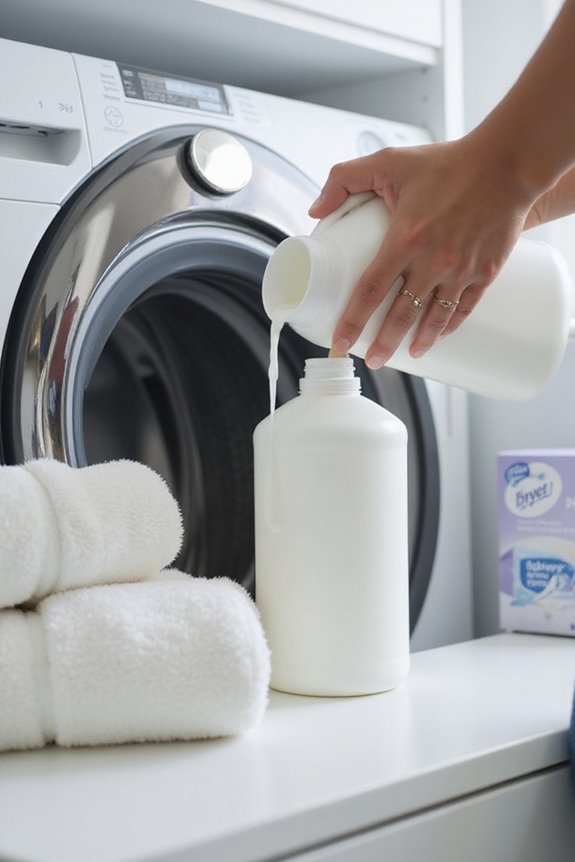
Fabric softener can be a game changer for our laundry routine, especially when using high-efficiency (HE) washers. It provides enhanced comfort by softening our fabrics, making clothes, towels, and bedding feel luxurious against our skin. We love how it keeps that freshly laundered softness, even after multiple washes. Plus, fabric softeners effectively reduce static, preventing our clothes from clinging uncomfortably to each other or to us—no more awkward moments! They also help minimize wrinkles, which means less time spent ironing. Isn’t that a win? Using fabric softener in HE washers aligns perfectly with their water-saving goals, all while extending the lifespan of our favorite textiles. Additionally, choosing products that are eco-friendly options can further enhance our laundry experience while being kind to the environment. So, let’s embrace the softness and freshness that fabric softener brings!
Cautions When Using Fabric Softener
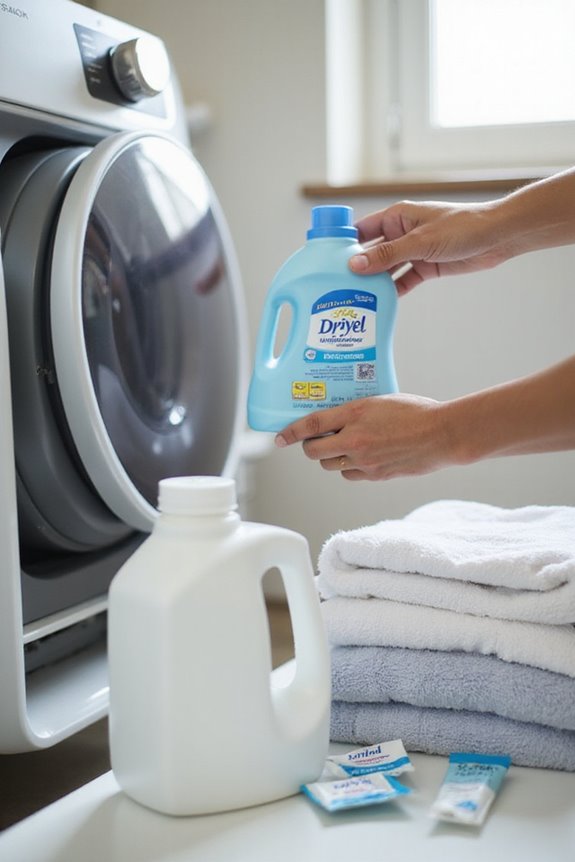
While we all appreciate the softness and freshness fabric softener brings to our laundry, there are some important cautions we should keep in mind. First off, let’s talk about skin sensitivity. Some of us may experience allergic reactions or irritation from the chemicals in fabric softeners. It’s a good idea to patch test if we’re unsure. We should also be cautious about chemical exposure, especially for those with asthma or eczema. Plus, overusing fabric softener can lead to residue buildup in our washers, potentially clogging dispensers. This not only affects our laundry but can also shorten our machine’s lifespan. So, let’s stick to the recommended amounts and avoid mixing it with detergents to keep everything in tip-top shape! Additionally, using hypoallergenic options can help mitigate the risk of skin irritation for those sensitive to chemical ingredients.
Storage and Handling of Fabric Softener
After considering the cautions we need to take when using fabric softener, it’s equally important to think about how we store and handle it. For ideal storage, let’s keep fabric softener in a cool, dry place, away from sunlight. We should always seal the container tightly when it’s not in use. Avoid placing it near heaters or ovens, as heat can alter its properties. When we measure out the softener, let’s use proper tools to prevent overuse. And remember, never add it directly to clothes! Following these safety precautions helps us avoid accidents, like kids or pets getting into it. Keeping our fabric softener in good condition guarantees it works effectively for our laundry, especially when using hypoallergenic options designed for sensitive skin.
Impact on Washer Performance
When we think about our washing machines, it’s easy to overlook how fabric softener can impact their performance. Using fabric softeners in high-efficiency washers can lead to fabric softener residues that accumulate inside the machine. This buildup can reduce washer efficiency and even affect how clean our clothes get. We might notice clothes feeling stiff or attracting dirt, which is definitely not what we want. Plus, if residues clog dispensers, our washers could face bigger mechanical issues down the road. So, while fabric softener might make our laundry smell nice, we should be mindful of how it affects our washers. Regular maintenance can help, but let’s be cautious with our fabric softener use to keep everything running smoothly!
Maintenance Tips for Fabric Softener Dispensers
To keep our high-efficiency washers running smoothly, it’s crucial to give some attention to the fabric softener dispensers. We should aim for regular dispenser cleaning at least once a month. This helps prevent residue build-up and guarantees our softener flows properly. When cleaning, remove the dispenser tray carefully—some parts even come apart for easier access. We can use lukewarm water and mild detergent, but let’s avoid soap on the drawer to keep buildup at bay.
If we notice our softener isn’t dispensing well, it’s time to up the maintenance frequency. A quick visual check can reveal clogs in those small exit holes. With a little effort, we can keep our washers happy and our clothes soft!
Choosing the Right Fabric Softener for HE Washers
Choosing the right fabric softener for our high-efficiency (HE) washers can make a world of difference in how our clothes feel and smell. We should look for liquid fabric softeners specifically labeled for HE machines. These typically have low-suds and low-residue formulations, which means they won’t leave that annoying waxy buildup.
Opting for plant-based or eco-friendly options is a great choice, not just for our clothes but for the planet too. Brands like Ensueño Max offer biodegradable formulas that smell amazing without harming our washer. It’s also smart to avoid using dryer sheets, since they’re not meant for HE washers. By choosing wisely, we can keep our clothes soft, fresh, and ready for anything!
Frequently Asked Questions
Can Fabric Softener Cause Allergies or Skin Irritation?
Yes, fabric softener ingredients can cause allergy symptoms like skin irritation and respiratory issues. We should be cautious, especially if we have sensitive skin or pre-existing conditions, and consider alternatives to minimize risks.
Is Fabric Softener Safe for Baby Clothes?
Is fabric softener safe for baby clothes? We think it’s a risky gamble! With baby skin so delicate, we should prioritize fabric safety by avoiding softeners to prevent irritation and keep our little ones safe and comfy.
How Does Fabric Softener Affect Microfiber Fabrics?
We’ve found that fabric softeners harm microfiber maintenance by coating fibers, reducing absorbency and cleaning efficiency. Instead, let’s explore fabric softener alternatives that enhance microfiber performance without damaging its integrity or effectiveness.
Can I Use Fabric Softener on Athletic Wear?
We shouldn’t use fabric softener on athletic wear, as it compromises moisture-wicking capabilities of athletic fabrics. Instead, let’s choose specialized detergents to keep our workout clothes breathable and effective during those intense training sessions.
What Are Eco-Friendly Fabric Softener Options for HE Washers?
When exploring eco-friendly fabric softener options for HE washers, we can try natural alternatives like DIY recipes using vinegar or essential oils. They soften fabrics effectively while being gentle on the environment and our skin.






